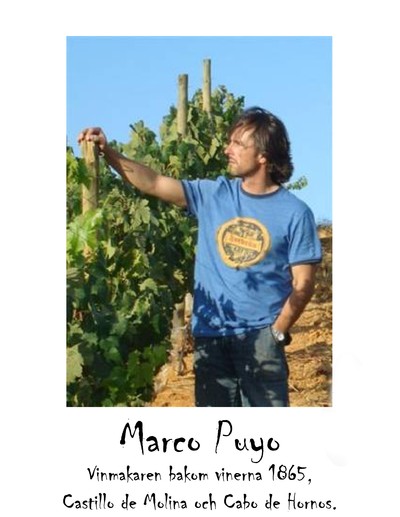2009-11-03
22:06:42
Exklusiv intverju med Marco Puyo, vinmakaren bakom vinerna 1865, Castillo de Molina och Cabo de Hornos

För en tid sedan gästade vinmakaren Marco Puyo Stockholm. I samband med detta hade Vin(gligt) förmånen att ställa en del kluriga frågor till honom. Eftersom jag som driver den här bloggen huserar i Kalmar hade jag ingen möjlighet att träffa honom personligen. Men vänliga Heléne på Pernod Ricard Sweden AB ställde upp med att vidareförmedla mina frågor.
Marco Puyo, som huserar i Chile, är vinmakare och hjärnan bakom vinerna 1865, Casillo de Molina och Cabo de Hornos som producenten Viña San Pedro framställer. 1865 samt Cabo de Hornos återfinns i sortimentet på Systembolaget. Vill du öka förståelsen för en vinmakares tankesätt så följer här mina frågor samt de svar som Marco Puyo levererade. Intervjun är på engelska.
Hello Marco Puyo!
- Which is your spontaneously thought about your wine?
- Is it traditional or modern?
Modern.
- Should it be drinken right the way or should it be kept in store for some years?
Most of them, thinking about Castillo de Molina, are meant to be enjoyed in a short to medium term. In the case of the reds 1865 Single Vineyard and Cabo de Hornos, those are wines to keep for some years.
- Who is the going to buy your wines?
Castillo de Molina always attracts new consumers, mainly through its varieties Sauvignon Blanc from Elqui and Pinot Noir. Our brands 1865 Single Vineyard and Cabo de Hornos, on the other hand, tend to allude to more experienced consumers.
- Do you have a clear picture for the most suitable consumer look like?
Depending on the occasion, consumers can find wines to drink every day in Castillo de Molina, which includes easy to understand-wines and very pleasant to enjoy. But Chile also offers very consistent wines for special occasions, to hold an in-depth conversation or mark an important date, such as 1865 Single Vineyard and Cabo de Hornos.
- How important is the bottle and the wine label for your wines?
The bottle is an important part of a wine’s look, but the most important part and key of a wine’s image is its label, which has to communicate the wine’s essence on an easy way, through a very direct message, which can be understood in two minutes.
- Describe shortly your typical day at Viña San Pedro?
I don’t have a typical day. Every day is different, and it is really difficult to find me two days on a row in the same place. I’m constantly moving from our winery in Molina, to visit the vineyards located almost all along the country, in the Maipo, Cachapoal, Maule, Leyda, Curicó and Elqui valleys, stopping at the headquarters in the capital, Santiago, and departing to journeys around the world to help promote our wines in tastings, fairs and expositions.
- In your procedure of making wine, do you do something special and unique, something you think you are alone of in the world of wine? If so, What?
Basically, the essence of my work lies in the grape’s origin, for example, in the huge difference about the Elqui Valley. And my great responsibility has been to discover this enormous difference and special character in Elqui and to take all the chances within San Pedro, betting for this origin. In terms of vinification, I let the Sauvignon Blanc to ferment at 10°C (a really very low temperature), and regarding the reds, I keep the skins still in contact with the most almost along the whole alcoholic fermentation (almost without pump-over or battonage).
- Which are the most important key factors behind your success as a wine maker?
I am very hard and critic about the wines I make, and I am very self-demanding and perseverant in the way I work and live wine.
- In the Swedish market more and more ask for more environmental products such as ecological and biodynamic wines. What´s your move to met up this increasingly demands from the customer?
San Pedro has long practiced a strong commitment to the environment with eco-friendly practices that include integrated farm management, a re-forestation program with a native endangered specie, state-of-the-art waste treatment, recycling, as well as farming a growing percentage of grapes organically (which gave birth to our 35°South Organic Wild Ferment range). Also, recently San Pedro launched an initiative to measure its Carbon Footprint in Molina, and in September 2009 began bottling Castillo de Molina and 35°South in lightweight bottles. But San Pedro’s aim is to take sustainability further, on a 360° philosophy, caring about the environment, our workers and their families, the communities where we are involved, to be a good place to work in, etc….
I do see a clear space for wines made with organically grown grapes, which offers lots of place to develop interesting projects, beyond only particular wines.
- Have Marco any more interest in life except wine?
Yes of course! My other great interests in life are my family and an intense search to balance work, my passion for wine and my family.
Väckte den här intervjun ett intresse för vinerna som Marco ligger bakom, provsmaka vinerna och döm själva om han är en vinmakare som faller dig i smaken.

